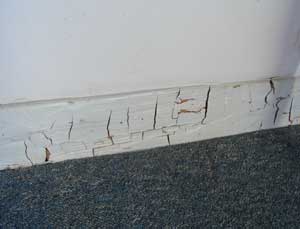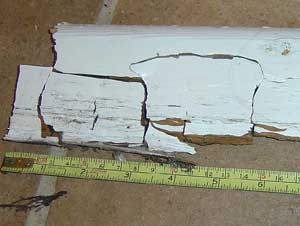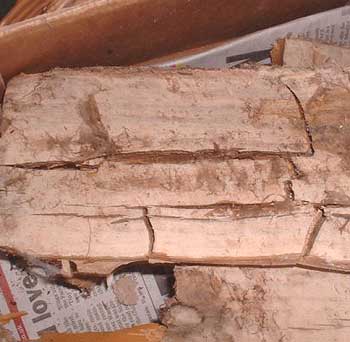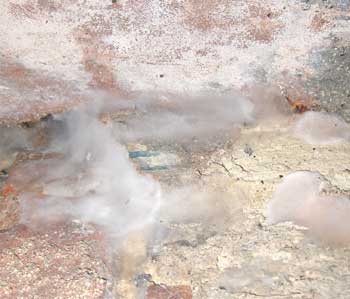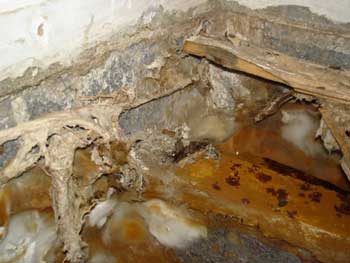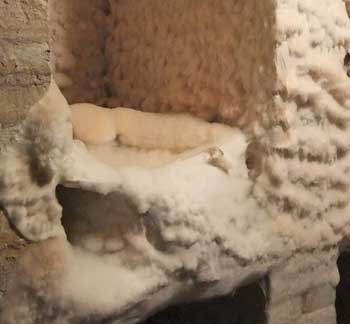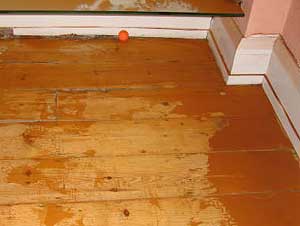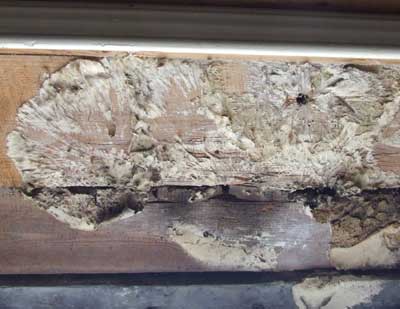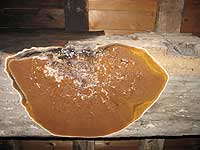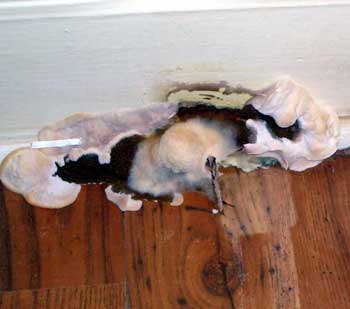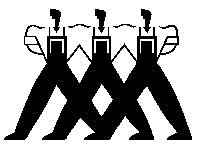DRY ROT SITE IMAGES
Copyright - D.C.Moore.
First signs of Dry rot are often seen in skirting boards - outward curvature (convex), deep cracks along the grain, strands
The skin of Dry Rot - Mycellium - with or without Strands of Dry Rot - on walls or below a timber floor
Fluffy Mycellium, like clouds of cotton wool, are a rarer form. Spore dust, rust red in colour. Normal Mycelium skin of Dry Rot.
A fresh Sporophore looks flat with a rust red centre, but as they dry out they can go dark brown to black in the middle.
Click here to see the products, check prices or place an Order
THERE IS ONLY ONE TRUE DRY ROT - SERPULA LACRYMANS
The dry rot fungus, Serpula lacrymans, is often regarded as the 'cancer' of a building. Many myths have built up concerning what this fungal decay is capable of doing, occasionally leading to the belief that the fungus is indestructible and that the whole of the building will have to be pulled down.
However, dry rot is vulnerable to certain environmental effects, and like all wood destroying fungi it has essential needs, and it is those needs that limit the extent of spread and damage that this organism can inflict. Unfortunately dry rot is a very secretive organism, favouring dark, damp stagnant conditions to develop. This is frequently why it is able to spread extensively before the damage is first noticed.
'Dry Rot and its Control' sets out to describe the fungus its biology, what it can and can't do, the conditions it must have, and most importantly how it can be readily controlled with the proper combination of environmental and building considerations coupled with the proper use of timber and masonry preservatives. Many people expect large volumes of chemicals to be used and that they will have to put up with the risk of any toxic effects and unpleasant odours and fumes which may be a part of the treatment.
Click here to see the products, check prices or place an Order
DRY ROT AND ITS CONTROL
The wood destroying fungus, Serpula lacrymans, is commonly known as dry rot. However, the name 'dry rot' might be considered rather inappropriate since like all wood destroying fungi it requires water for germination, growth and survival. Indeed, water/dampness is the fundamental need of all wood destroying fungi plus, of course, a food source (wood); without either the fungus ceases to grow and dies.
Click here to see the products, check prices or place an Order
WOOD AS A FOOD SOURCE FOR DRY ROT
Wood is a natural material being the end product of a complex chemical process, photosynthesis, which occurs in green plants. Wood basically consists of boxes and tubes made of sugars which are linked together to form cellulose, the basic building material of plants. Chains of cellulose are laid down in different orientations and bonded by another material, hemicellulose. A further material, lignin, adds rigidity and strength. It is the arrangement of cellulose with the two other materials which give wood its characteristic properties and its 'cellular' structure. The wood forming the outer part of the tree is known as the sapwood and transports sap and stores food. This is the most vulnerable part of wood to fungal decay and attack by wood-boring insects. The inner wood is the heartwood and forms the older wood in the centre of the tree; it does not conduct sap or store food but it does contain some excretory products and is more resistant to decay than the sapwood. It is also more resistant to the movement of water and preservatives in general. The heartwood of different timbers varies in its resistance to fungal decay and it is this heartwood resistance to decay by which timbers can be classified, i.e., non-durable, durable, etc.
Click here to see the products, check prices or place an Order
HOW DRY ROT CAUSES WOOD DECAY
Wood decay is basically the reverse of wood formation. Dry rot attacks the cellulose and hemicellulose of the wood to break it back down into its basic sugar components . The sugars are respired with air by the fungus to produce carbon dioxide, water and the energy for growth. However, the lignin is not metabolised and this gives rise to the darkening in colour of the wood. A number of wood destroying fungi other than dry rot also decay the wood in the same manner, leaving the lignin untouched. The characteristic darkening of the wood by these fungi together with the typical cuboidal cracking give them the title of 'brown rots'; dry rot is one of the brown rots. When the wood is broken down and utilised for food, shrinkage, loss of weight, loss of strength and cracking occur. It is the shrinkage which causes the typical 'cuboidal' cracking (cracks to form small cubes) of dry rot and the other 'brown rots'. Indeed, it is this shrinkage and cracking which is often the first signs of a problem.
Click here to see the products, check prices or place an Order
Books - guides to Dry Rot, Wet Rot, Wood Boring Insects, Moulds and Damp
Buy Books
Buy Identifying Wood Boring Insects, Rots and Moulds: full colour: BRE.
Identifying Dampness in Buildings: Coleman - buy the Reprinted Book
Identifying Dampness in Buildings: Coleman - buy a direct Download
Click here to see the products, check prices or place an Order
Returns Policy | Technical & Safety
Property Repair Systems,
T: 01626 872886
Site written by: David Moore
David Moore, B.A. (Hons.), C.T.I.S., C.R.D.S. Technical Author
Google+
